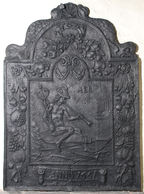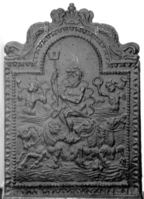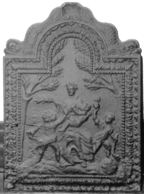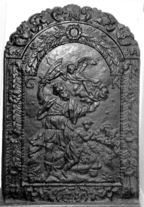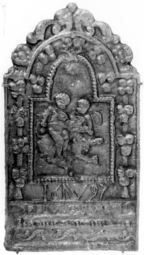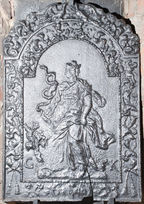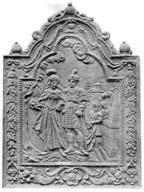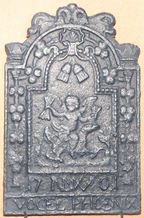-
97
Description: Arched rectangular shaped central panel with bead edging; naked figure of Mercury/Hermes with winged helmet (petasos), holding a snake-entwined staff (caduceus); he is sitting astride a pair of bellows and blowing a straight trumpet; a twice-bent trumpet lies at his feet; the bellows are pumping air into an organ; to the right of his head is the word, AER (air - Latin); above is a swag of drapery; arched rectangular shaped border with ovolo edging; floral wreath at top with suspended swags of fruit and leaves, including, grapes, pomegranates and apples; inscription, ‘ANNO 1661’, on a scroll at the bottom; scallop shell and sea serpents on top.
Notes: One of a series of firebacks symbolising the four elements.
Copies of this fireback are known.
Inscription: AER / ANNO 1667
- Decoration tags:
- 'Dutch' (shape)
- ovolo (edging)
- whole carved pattern
- mythological
- allegorical
- text
- humans
- objects
Manufactured: in 1667 possibly in the Siegerland area of Germany.
Current location: Nymans, Staplefield Road, Handcross, Slaugham, West Sussex, England.
Museum number: 1206008 (part of the National Trust museum group)
- Attached to series:
- 'Dutch' Miscellaneous Firebacks
- Elements firebacks
-
104
Description: 'Dutch' style; arched rectangular shaped central panel with arch at top; bead edging; female figure with staff and fan in a garden, inscription DER MITAG below figure ; similarly shaped border of Corinthian columns and floral decoration; symmetrical serpents on top.
Notes: The inscription means NOON; identified from a clearer version in the collection of the Haardplatenmuseum, Klarenbeek, Netherlands. The representations in human form of various virtues and vices in Iconologia, by Cesare Ripa, first published in the early 17th century but republished in different editions many times subsequently, formed the basis of the subject matter of several firebacks, mostly cast from continental originals, that became popular in England from the late 17th century.
Copies of this fireback are known.
Inscription: DER MITAG
- Decoration tags:
- 'Dutch' (shape)
- fillet (edging)
- whole carved pattern
- pictorial
- allegorical
- text
- humans
Manufactured: in the mid- to late-17th century possibly in the Siegerland area of Germany.
Current location: Haslemere Educational Museum, Haslemere, Surrey, England.
(part of the Haslemere Educational Museum museum group)
- Attached to series:
- 'Dutch' Miscellaneous Firebacks
-
110
Description: Arched rectangular shaped central panel with fillet and bead edging, Neptune/Poseidon, holding a trident in his right hand, sitting in a scallop shell drawn by four mythical sea horses, behind are two mermaids; arched rectangular shaped border with ovolo egg and dart edging; above, two symmetrical dolphins with a clam shell between.
Notes: Typical type of firebacks produced in Germany for the Dutch market; the central panel was made separately for insertion into different borders; this border is a relatively simple type. Formerly part of the Ade Collection (from Grove Hill, Hellingly, Sussex).
Copies of this fireback are known.
- Decoration tags:
- 'Dutch' (shape)
- ovolo, egg and dart (edging)
- carved pattern panels
- mythological
- animals
- humans
Manufactured: in the mid- to late-17th century possibly in the Siegerland area of Germany.
Current location: Hastings Museum and Art Gallery, John's Place, Bohemia Road, Hastings, East Sussex, England.
Museum number: HASMG: 1952.51.36 (part of the Hastings Museum museum group)
Citation: Lloyd, N., 1925, 'Domestic Ironwork I', Architectural Review, 58, pp. 58-67.
- Attached to series:
- 'Dutch' Miscellaneous Firebacks
- 'Dutch' Dolphin series
-
138
Description: 'Dutch' style; arched rectangular shaped central panel with bead edging, figure of Charity holding a baby in her left arm and an olive branch in her right, two other children stand on each side of her, one holding a burning heart, trees in the background; arched rectangular shaped border with fillet edging and a repeated leaf pattern; on top a clam shell between two symmetrical serpents.
Notes: Typical type of fireback produced in Germany by Dutch pattern makers; the central panel was made separately for insertion into different borders; this border is a relatively simple type; the portrayal of Charity is derived from the 'Iconologia' of Cesare Ripa. Formerly part of the Ade Collection (from Grove Hill, Hellingly, Sussex).
Copies of this fireback are known.
- Decoration tags:
- 'Dutch' (shape)
- fillet (edging)
- carved pattern panels
- allegorical
- humans
- plants
Manufactured: in the mid- to late-17th century possibly in the Siegerland area of Germany.
Current location: Hastings Museum and Art Gallery, John's Place, Bohemia Road, Hastings, East Sussex, England.
Museum number: HASMG: 1952.51.40 (part of the Hastings Museum museum group)
Citation: Lloyd, N., 1925, 'Domestic Ironwork I', Architectural Review, 58, pp. 58-67.
- Attached to series:
- 'Dutch' Miscellaneous Firebacks
- Charity firebacks
-
139
Description: Arched rectangular shaped central panel with bead-and-pellet edging; figure of Abraham, a scimitar in his raised right hand, which is being restrained by an angel emerging from a cloud; Isaac is kneeling to Abraham's left and a ram is caught in a bush to the left of the plate; the initials are in the top corners; arched rectangular shaped border with fillet edging, and swags of leaves suspended from flowers; on top, symmetrical foliate swirls.
Notes: The design is an adaptation of an engraving by Adriaen Collaert (1555-1623) of a painting by Maarten de Vos (1532-1603), Plate 5 of The Story of Abraham. In the 'Thesaurus sacrarum historiarum veteris testamenti', published in Antwerp by Gerard de Jode (1509-1591) in 1579, 1585 and, subsequently, by Visscher in 1589. One of a small group of firebacks, all of similar shape, some with biblical designs, others mythological, all dated around 1700 and bearing the letters GK. Formerly part of the Ade Collection (from Grove Hill, Hellingly, Sussex).
Copies of this fireback are known.
Inscription: G K / 1700
- Decoration tags:
- 'Dutch' (shape)
- fillet (edging)
- whole carved pattern
- individual letters
- biblical
- text
- humans
Manufactured: in 1700 in the Siegerland area of Germany.
Current location: Hastings Museum and Art Gallery, John's Place, Bohemia Road, Hastings, East Sussex, England.
Museum number: HASMG: 1952.51.37 (part of the Hastings Museum museum group)
Citation: Lloyd, N., 1925, 'Domestic Ironwork I', Architectural Review, 58, pp. 58-67.
- Attached to series:
- 'Dutch' GK series
- Old Testament & Apocrypha firebacks
- Abraham & Isaac firebacks
-
187
Description: 'Dutch' style; arched rectangular shaped central panel, bead edging, two children sitting astride a beast (possibly a winged ram); arched rectangular shaped border, fillet edging, swags of fruit bunches suspended from ribbon; on top, symmetrical floral swirls and flowers.
Notes: The image is probably intended to be Phryxus and Helle riding the winged ram with the golden fleece, but in recasting it has been misinterpreted as the young Samson slaying the lion at Timnath; Judges 14: 5-6. Formerly part of the Ade Collection (from Grove Hill, Hellingly, Sussex).
Copies of this fireback are known.
Inscription: 16 NDW 97 / DER IUNGE SAMSON [the young Samson]
- Decoration tags:
- 'Dutch' (shape)
- fillet (edging)
- whole carved pattern
- mythological
- monogram
- text
- humans
Manufactured: in 1697 possibly in the Siegerland area of Germany.
Current location: Hastings Museum and Art Gallery, John's Place, Bohemia Road, Hastings, East Sussex, England.
Museum number: HASMG 1952.51.28 (part of the Hastings Museum museum group)
- Attached to series:
- 'Dutch' NDW series
-
981
Description: Arched rectangular shape; fillet edging; broad, fillet-edged central panel with pictorial landscape and battle scene; on top, above a cone of laurel leaves, a crown supported by two putti, each holding a plant stem; on each side, a flower and fruit festoon suspended on a ribbon from a ring; at the bottom , inscription on a scroll.
Notes: The pictorial scene is alleged to be the Siege of Namur of 1695 in which British and Dutch forces, under the leadership of William III, defeated the French forces of Louis XIV, however details of the scene more closely resemble those seen in images of the Siege of Vienna in 1683, an iconic victory of the Christian powers over the Ottoman Turks.
Copies of this fireback are known.
Inscription: NON[...]ROSEDARMIS / N ANNO 1695 L
- Decoration tags:
- 'Dutch' (shape)
- fillet (edging)
- whole carved pattern
- individual letters
- pictorial
- text
- animals
- humans
- plants
- objects
Manufactured: in 1695 possibly in the Siegerland area of Germany.
Current location: Swakeley's House, Ickenham, Middlesex, England.
Citation: Godfrey, W. H., 1933, Survey of London Monograph 13, Swakeleys, Ickenham (London, HMSO).
- Attached to series:
- 'Dutch' 1695 Crown series
-
344
Description: Arched rectangular central panel, with bead-and-pellet edging; pictorial, standing female figure in classical dress, facing to the left, holding a snake in her right hand, a bunch of flowers at lower left; the initials located in bottom corners; arched rectangular border, fillet edging, containing swirled foliage, with a putto in the top corners; on top, two perched bird facing each other, with swirled foliage descending behind them.
Notes: The figure is of Sapientia, or Wisdom, based closely on an engraving, one of a set entitled 'The Virtues' by Hendrik Goltzius c.1593; a small number of firebacks bear the initials, GK; it is not known to whom they refer, but dated ones are of 1700.
Copies of this fireback are known.
Inscription: G K
- Decoration tags:
- 'Dutch' (shape)
- fillet (edging)
- whole carved pattern
- pictorial
- allegorical
- text
- humans
Manufactured: in the early-18th century in the Siegerland area of Germany.
Current location: Ightham Mote, Ightham, Kent, England.
Museum number: 825381 (part of the National Trust museum group)
- Attached to series:
- 'Dutch' GK series
-
863
Description: Arched rectangular central panel with additional arch above; bead and fillet edging; pictorial scene of, on the left, a tree next to a female and, in the centre, a male figure, both in eastern dress, a page behind holding a train, and to the right a short obelisk surmounted by a crescent, behind which is the head of a figure with a camel; behind is a small building also surmounted by a crescent, with clouds above; the word, ASIA, is centre bottom; identical shaped border with cavetto-moulded edging; a pomegranate on top with descending swags of drapery; at the sides, overlapping bunches of foliage suspended from ribbon bows; at the bottom, a central cartouche between fruit bunches; on top, a pomegranate with a descending serpent on each side, and a pomegranate on each shoulder of the plate.
Notes: A pastiche of the EUROPA design based on an engraving c.1642 of Friedrich Wilhelm, Elector of Brandenburg, and his wife, Luise Henriette of Oranje-Nassau, by Mathias Czwiczek, with the figures adopting very similar poses in an oriental setting; one of a series depicting allegories of the four continents.
Copies of this fireback are known.
Inscription: ASIA / MB
- Decoration tags:
- 'Dutch' (shape)
- cavetto (edging)
- whole carved pattern
- pictorial
- allegorical
- monogram
- text
- humans
Manufactured: in the mid- to late-17th century possibly in the Siegerland area of Germany.
Current location: not known.
- Attached to series:
- 'Dutch' Arched arch types
- 'Dutch' Continents firebacks
-
377
Description: Arched rectangular central panel with bead on fillet edging and two tassels hanging from top of arch; pictorial image of a cherub with arrows in both hands sitting on a phoenix; arched rectangular border with fillet edging; scallop shell at top with descending ribbons and fruit clusters; date and monogram below central panel; bottom panel with inscription; on top, two sea serpents, with open buds on shoulders of recatngle.
Notes: The customary monogram on such firebacks is NDV. Several anglicised versions of this type of fireback exist. Formerly part of the J. H. Every collection.
Copies of this fireback are known.
Inscription: 17 NDW 01 / VOGEL PHOENIX [bird phoenix]
- Decoration tags:
- 'Dutch' (shape)
- fillet (edging)
- whole carved pattern
- pictorial
- mythological
- text
- humans
Manufactured: in 1701 in the Siegerland area of Germany.
Current location: Anne of Cleves House, Southover High Street, Lewes, East Sussex, England.
Museum number: 1944.24.087 (part of the Sussex Archaeological Society museum group)
- Attached to series:
- 'Dutch' NDW series
